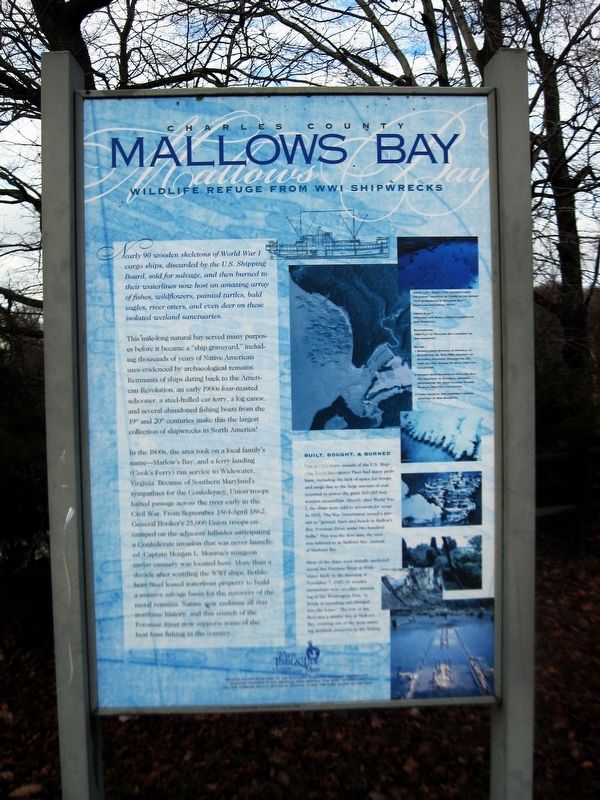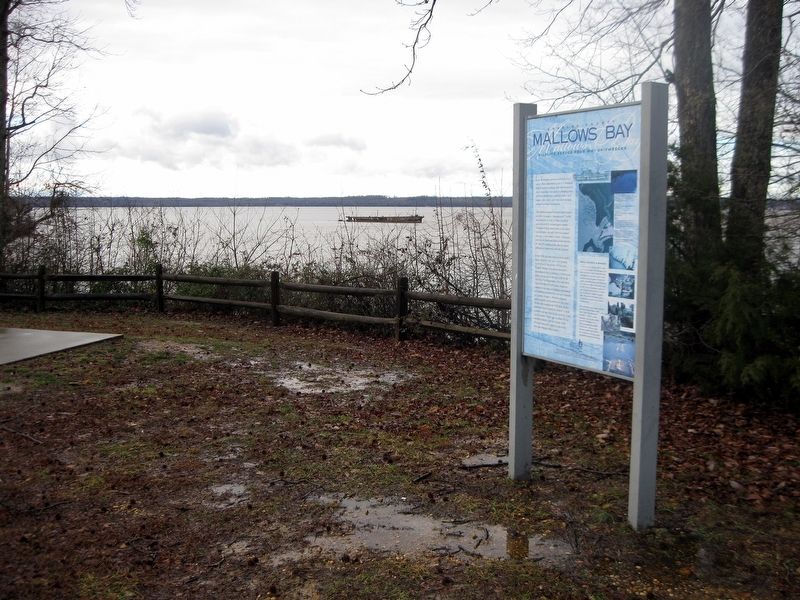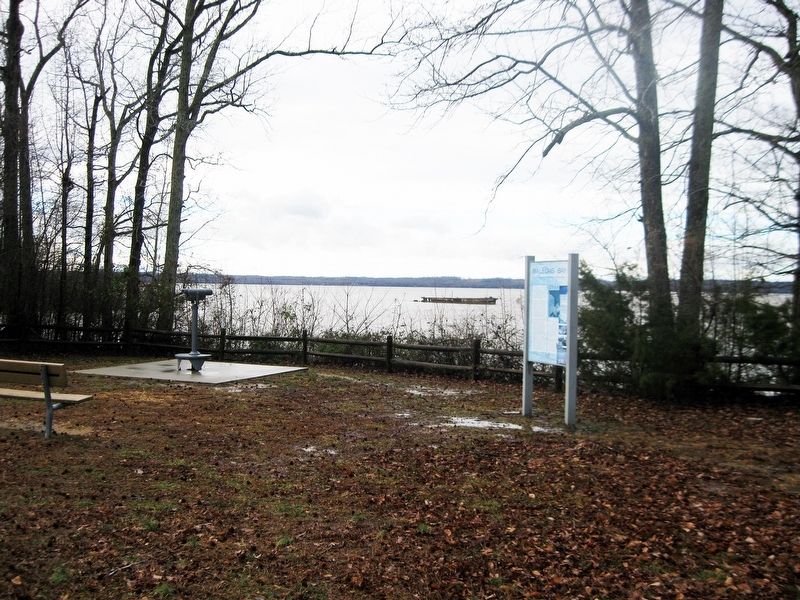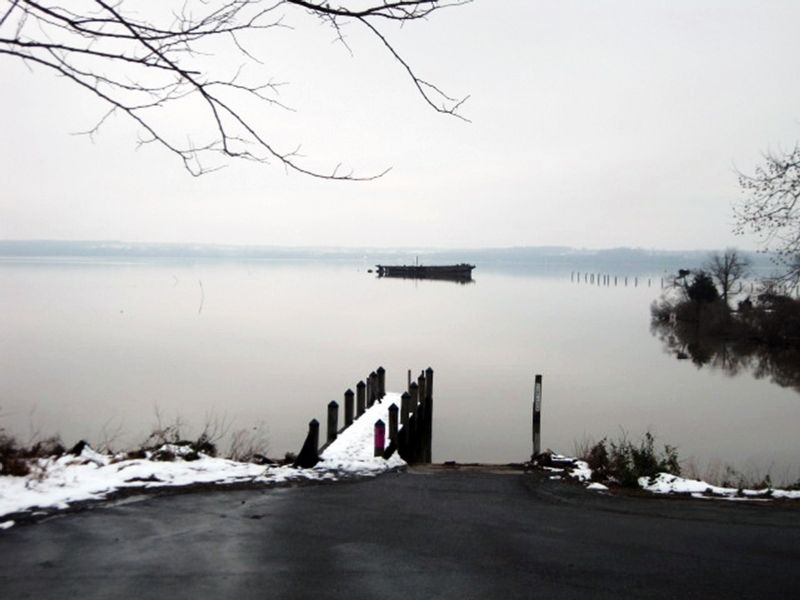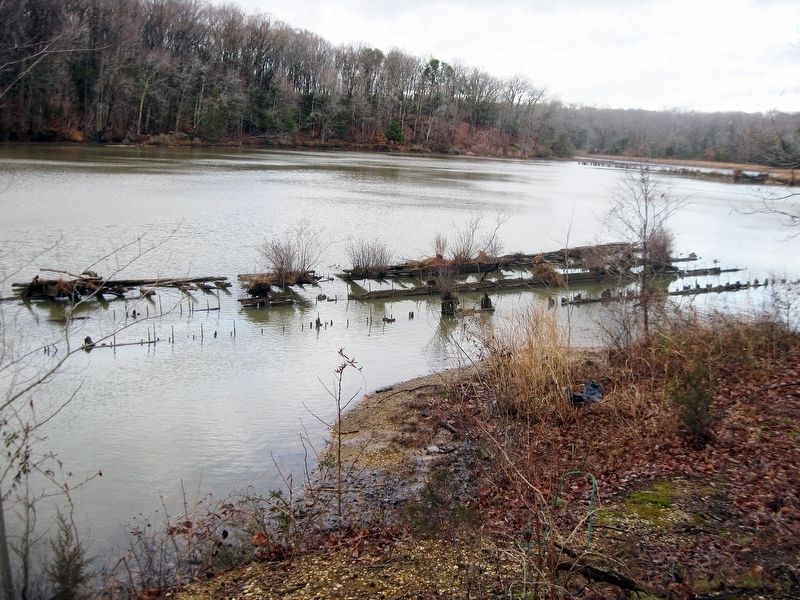Nanjemoy in Charles County, Maryland — The American Northeast (Mid-Atlantic)
Mallows Bay
Wildlife Refuge from WWI Shipwrecks
Nearly 90 wooden skeletons of World War I cargo ships, discarded by the U.S. Shipping Board, sold for salvage, and then burned to their waterlines now host an amazing array of fishes, wildlflowers, painted turtles, bald eagles, river otters, and even deer on these isolated wetland sanctuaries.
This mile-long natural bay served many purposes before it became a "ship graveyard," including thousands of years of Native American uses evidence by archaeological remains. Remnants of ships dating to the American Revolution, and early 1900s four-masted schooner, a steel-hulled car ferry, a log canoe, and several hundred abandoned fishing boats from the 19th and 20th centuries make this the largest collection of shipwrecks in North America!
In the 1800s, the area took on a local family's name—Mallow's Bay, and a ferry landing (Cook's Ferry) ran service to Widewater, Virginia. Because of Southern Maryland's sympathies for the Confederacy, Union troops halted passage across the river early in the Civil War. From September 1861—April 1862, General Hooker's 25,000 Union troops encamped on the adjacent hillsides anticipating a Confederate invasion that was never launched. Captain Morgan L. Monroe's sturgeon caviar cannery was located here. More than a decade later after scuttling the WWI ships, Bethlehem Steel leased the waterfront property to build a massive salvage basin for the recovery of the metal remains. Nature now reclaims all this maritime history, and this stretch of the Potomac River now supports some of the best bass fishing in the country.
Built, Bought, & Burned
The quickly-made vessels of the U.S. Shipping Board Emergency Fleet had many problems, including the lack of space for troops and cargo due to the large amount of coal required to power the giant 265-285 foot wooden steamships. Shortly after World War I, the ships were sold to investors for scrap. In 1925, The War Department issued a permit to "ground, burn, and beach in Mallow's Bay, Potomac River, some two hundred hulls." This was the first time the area was referred to as Mallows's Bay, instead of Marlow's Bay.
Many of the ships were initially anchored across the Potomac River at Widewater. Early in the morning of November 7, 1925, 31 wooden steamships were set afire. According to the Washington Post, "a horde of squealing rats plunged into the water." The rest of the fleet met a similar fate at Mallow's Bay, creating one of the most amazing wetlands preserves in the Nation.
(Black & white drawing of a ship.)
Above Left: Hough Type wooden cargo steamship courtesy of Ferris the the report "The Steamwrecks of Mallows Bay," Maryland Historical Trust.
(Photos
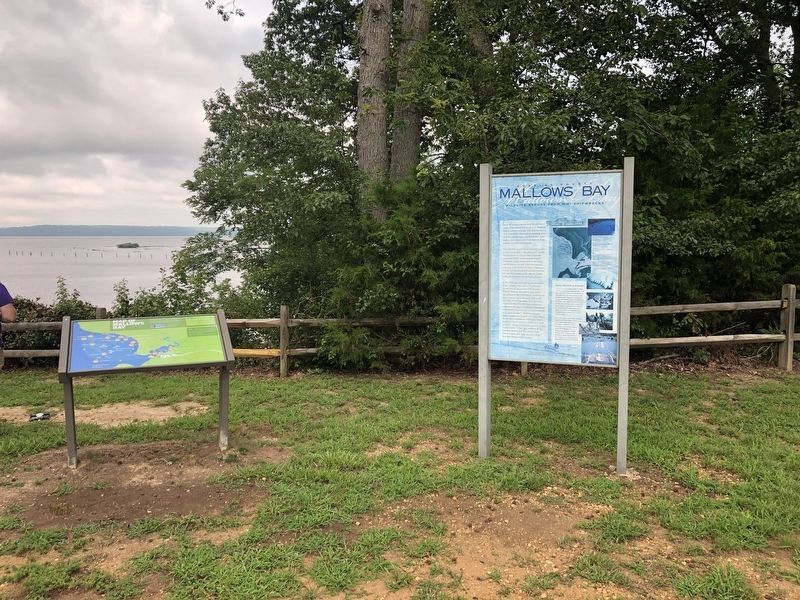
Photographed By Devry Becker Jones (CC0), August 14, 2020
2. Mallows Bay marker with the Map of Mallows Bay sign
Above & Left:
Infrared and aerial photos courtesy of Don Shomette.
(Plat map.)
Background:
1928 Plat of Mallows Bay courtesy of Don Shomette.
(Images of shipwrecks.)
Below:
1. Wooden ships burning in Potomac at Widewater, VA. Nov. 1925. Courtesy of National Archives, Washington, DC, from Calvert Marine Museum, Fred Tilp Collection.
2. Wooden Ships Burning at Mallows Bay, MD. Courtesy of National Archives, Washington, DC, from Calver Marine Museum, Fred Tilp Collection.
3. Three wildlife and shipwreck photos, courtesy of Don Shomette.
(Logo of the Southern Maryland Heritage Area Consortium)
Wayside exhibit developed by the Southern Maryland Heritage Partnership. Funding provided by the National Park Service. For more information call the Charles County Office of Tourism at 800 766-3386 or 800 SO MD FUN.
Erected by Southern Maryland Heritage Area Consortium, National Park Service, and the Charles County Office of Tourism.
Topics. This historical marker is listed in these topic lists: Environment • Native Americans • War, World I • Waterways & Vessels. A significant historical date for this entry is November 7, 1925.
Location. 38° 28.1′ N, 77° 15.8′ W. Marker is in Nanjemoy, Maryland, in Charles County. Marker
can be reached from Wilson Landing Road, 0.7 miles west of Riverside Rd. Marker located in a small clearing half-way between the bulletin board at the start for the Mallows Bay Hiking Trail and the boat ramp. Touch for map. Marker is at or near this postal address: 1440 Wilson Landing Road, Nanjemoy MD 20662, United States of America. Touch for directions.
Other nearby markers. At least 8 other markers are within 3 miles of this marker, measured as the crow flies. A different marker also named Mallows Bay (within shouting distance of this marker); Points of Interest (about 300 feet away, measured in a direct line); Archeology Reveals Outbuildings (approx. 1.8 miles away); Life Cycle of a House (approx. 1.8 miles away); Memories of Douglas Point (approx. 1.8 miles away); Minister's House, Family Farm (approx. 1.8 miles away); Unique Environment (approx. 1.8 miles away); Washington's Farm (approx. 2.7 miles away). Touch for a list and map of all markers in Nanjemoy.
Also see . . .
1. Mallows Bay-Potomac River National Marine Sanctuary. NOAA website entry (Submitted on January 27, 2019.)
2. Mallows Bay-Potomac River National Marine Sanctuary. Charles County Recreation and Parks website entry (Submitted on January 27, 2019.)
3. Mallows Bay. Chesapeake Conservancy website entry (Submitted on January 27, 2019.)
4. Mallows Bay Potomac River National Marine Sanctuary. Maryland's Department of Natural Resources website entry (Submitted on January 27, 2019.)
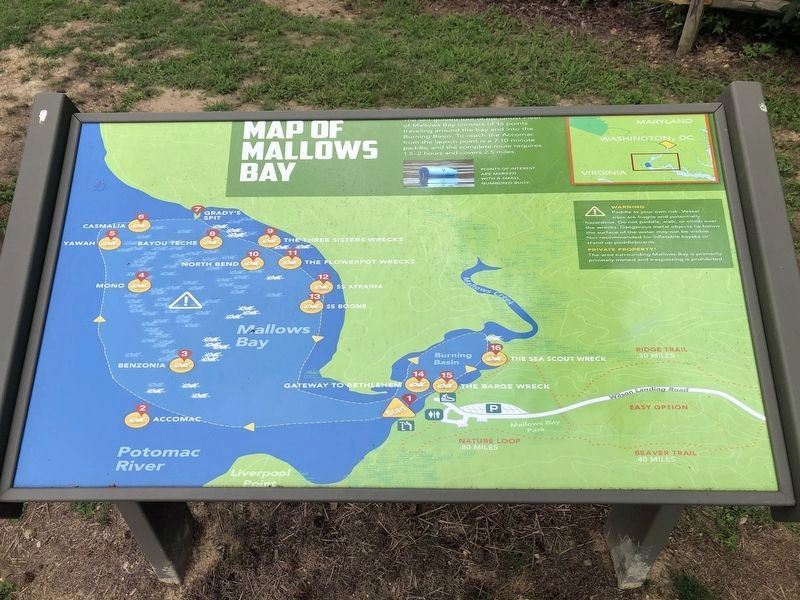
Photographed By Devry Becker Jones (CC0), August 14, 2020
5. Map of Mallows Bay
Sign near the marker showing a map of fleet locations.
Credits. This page was last revised on February 17, 2022. It was originally submitted on January 27, 2019. This page has been viewed 329 times since then and 35 times this year. Photos: 1. submitted on January 27, 2019. 2. submitted on August 14, 2020, by Devry Becker Jones of Washington, District of Columbia. 3, 4. submitted on January 27, 2019. 5. submitted on August 14, 2020, by Devry Becker Jones of Washington, District of Columbia. 6, 7. submitted on January 27, 2019. • Bill Pfingsten was the editor who published this page.
